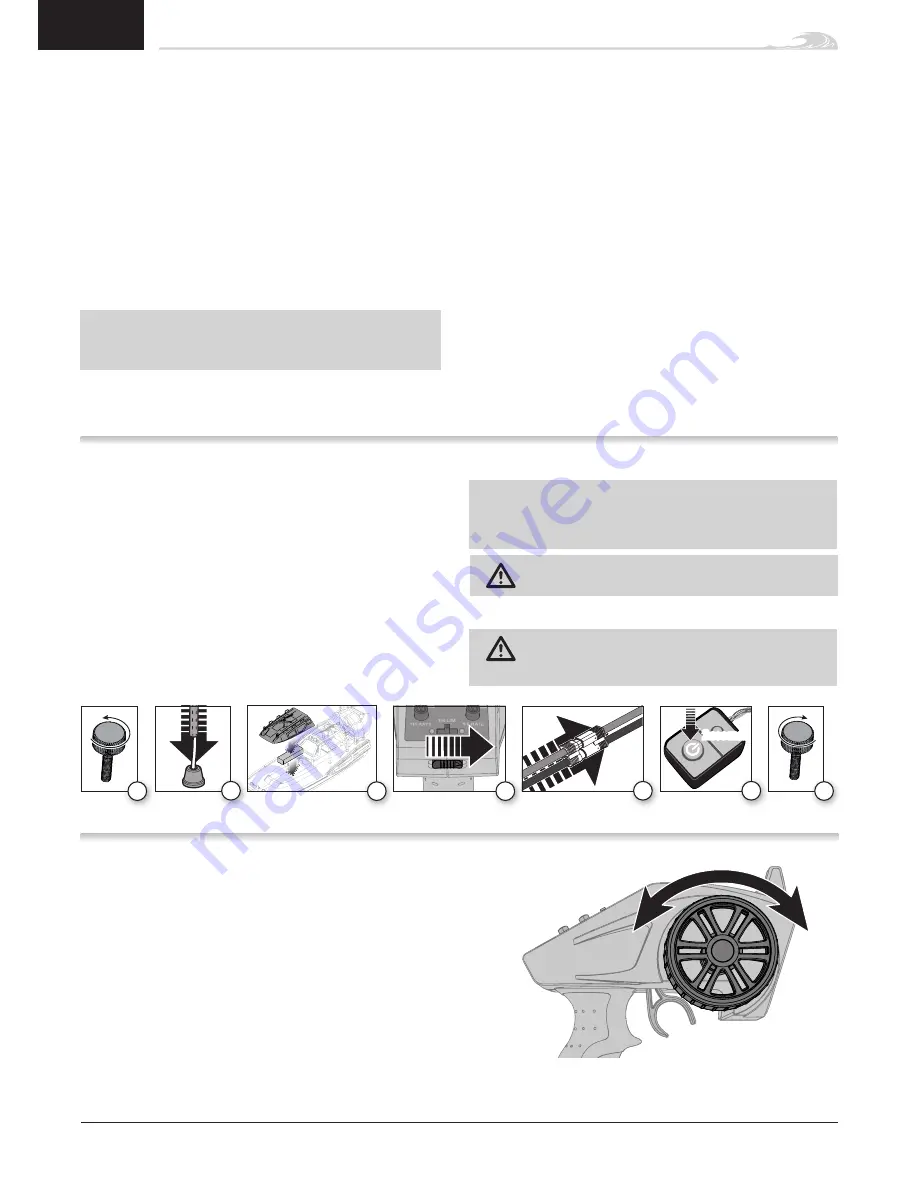
1. Remove the canopy from the hull.
2. Install the receiver antenna in the antenna tube.
3. Install the fully charged battery in the compartment and
secure it with hook and loop tape.
4. Power on the transmitter. Ensure the throttle is not
reversed and the throttle trim is neutral.
5. Connect the battery to the ESC.
6. Keep the throttle at neutral and power on the ESC by
pushing the power switch.
• Once armed, the ESC will beep and the LED will flash,
indicating the number of battery cells it has detected.
• 1 short beep will sound when the ESC is ready to run.
NOTICE:
Pressing and holding the ESC
SET
button for 3
seconds allows you to change the battery chemistry from
LiPo to NiMH. Refer to
Electronic Speed Control (ESC)
Programing
for more information.
CAUTION:
Never use a LiPo battery in NiMH mode
or battery damage will result.
7. Install the canopy on the hull.
WARNING:
Never handle the boat using the cage
as it encloses the propeller. Damage to the boat or
your fingers may result.
Getting Started
Control Check
IMPORTANT:
Perform a control check at the beginning
of each boating session, after repair, or after installation
of new batteries.
Ensure the receiver antenna is extended properly and all
batteries are fully charged.
1. Power ON the transmitter and the boat.
Do not install the battery compartment.
2. Place the boat on a steady surface.
3. Check steering and throttle on the transmitter.
2.4GHZ DIGITAL
RADIO SYSTEM
2.4GHZ DIGITAL
RADIO SYSTEM
The factory default setting for the LVC in the ESC included with
your boat is set at 3.2V per cell. Discharging a Li-Po battery
below 3V per cell may damage your battery. The included
ESC protects the boat battery from over-discharge using Low
Voltage Cutoff (LVC). Before the battery charge decreases too
much, LVC removes power supplied to the motor.
The boat drastically slows or stops completely once LVC is
activated. Releasing the throttle and reapplying it will provide
a limited amount of power to safely return the boat to shore.
Repeated use after LVC is activated will damage the batteries.
Once LVC has been activated, the ESC status light will flash
red continuously, indicating that the ESC is in LVC mode.
NOTICE:
The LVC reserves battery capacity to allow you
to safely return your boat to shore. Continued use after
LVC has activated will damage your battery.
LVC can activate prematurely if you use (1) low C-rated
batteries or (2) old, worn, and/or weak batteries.
The average run time—using the recommended batteries
(
DYNB3803EC
or
DYNB3804EC
)—is between 5–7 minutes at
non-stop, open throttle. Limited run time may indicate worn or
weak batteries.
Tip:
If you’ve installed freshly charged batteries, and LVC
activates within the first minute of operation, replace your
worn or weak batteries with the recommended batteries.
Tip:
Monitor your boat battery’s voltage before and after
boating by using a Li-Po Cell Voltage Checker (EFLA111,
sold separately).
Disconnect and remove the Li-Po battery from the boat after
use to prevent trickle discharge. Charge your Li-Po battery to
half capacity before storage. During storage, make sure the
battery charge does not fall below 3V per cell. LVC does not
prevent the battery from over-discharge during storage.
Low Voltage Cutoff (LVC)
Aerotrooper 25-Inch Brushless Air Boat RTR
6
EN
2
2
2
5
6
4
1
7
2 seconds
3

































